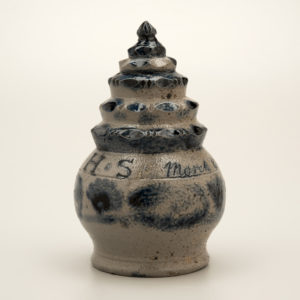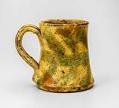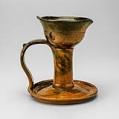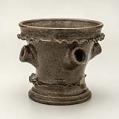Collection: Mariner Southern Ceramics Gallery: Purpose

Bank
Henry Remmey
Baltimore, Maryland
1828
Salt-glazed stoneware
The William C. and Susan S. Mariner Collection (5813.70)
The product lines of the profit-driven potters of the South were based on the needs of their local communities. While industrially-produced, imported English ceramics provided much of the everyday wares for dining, the bulk of locally-made pottery were the jugs, jars, bottles, crocks, churns, milk pans, and butter pots essential for everyday food storage and preservation. Chamber pots were essential for personal hygiene, while specialty forms were produced to fulfill a variety of household and personal functions, from heating to lighting to money savings.
German cultures in America often preferred ceramic stoves to fireplaces for interior heating. The Moravian potters in both Salem and Bethabara, North Carolina, created individual press-molded earthenware tiles to build ceramic stoves, like this mottle-glazed example.
Fat lamps were a traditional lighting device produced by American redware potters, but ceramic candlesticks, like the Baltimore stoneware example here, were relatively rare. Coin banks were occasionally made as specialty items, but this highly ornamented Baltimore example dated 1828 was clearly a presentation piece.
Flowerpots are a common ornamental pottery form, but of particular note is this alkaline-glazed stoneware vase made by Lucius Jordan of Washington County, Georgia, about 1850. It is highly decorated three spouts, two bands of ruffles, and the potter’s initials “LJ” in three locations. This form is sometimes referred to as a “wedding vase” in parts of Georgia and Alabama.








